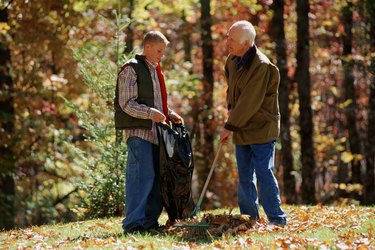
Although properly sited trees can add significant value to residential lots or other landscapes, the vegetative debris they produce is a frequent source of dispute between neighbors and property owners. Pruning trees, removing debris and otherwise maintaining them in accordance with local laws can help resolve such disputes amicably or prevent them from occurring.
Naturally Occurring Debris
Video of the Day
Property owners are not responsible for naturally occurring debris from their trees that falls onto adjacent lots. Twigs, leaves, fallen acorns and sap are all considered the responsibility of the owner of the lot on which they fall, rather than the owner of the tree, provided the debris does not do significant damage to structures or landscaping. Vegetative debris from healthy trees is not generally a basis for pursuing legal action against the owner of the tree, in any state, unless it constitutes a hazard or a nuisance.
Video of the Day
Nuisance vs. Hazard Trees
Nuisance trees are defined as those that pose no threat to property or life, but do interfere with the reasonable enjoyment of said property. This includes trees with overhanging or otherwise encroaching branches, as well as those that provide unwanted shade or vegetative debris. Hazard trees, however, are those with obvious defects that pose a significant threat to life or property. An unhealthy tree with dead limbs overhanging a house or play area in an adjacent lot, for example, would be classified as a hazard.
Self-Help
Case law and statutory law dictate that property owners should exercise the right of "self-help" to deal with nuisance trees. Self-help is the right of property owners, in all states, to remove tree branches or other debris themselves, without going to court. Although legal action is an option in cases where self-help is not practicable, most states define the self-help doctrine as a property owner's primary recourse when dealing with encroaching branches or fallen leaves. Hazard trees, in contrast, are the sole responsibility of the owner of the lot on which they reside, and the law requires hazards to be dealt with as soon as they are noted, at the owners' expense.
Resolving Disputes
Resolving disputes about tree debris amicably with neighbors is always preferable to legal action, though property owners in most states do have the option of legal recourse, if the landowners involved are unable or unwilling to solve the problem. Contact the owners of neighboring lots and speak to them in person, if possible. Such disputes can often be resolved by trimming tree branches in such a way that fewer leaves are shed in neighboring lots. Owners of trees should avoid crossing into adjacent lots to trim branches or remove debris without obtaining permission in advance from the landowners.
- University of Minnesota Forest Resources Extension: Hazard Trees and Limbs on Private Property
- University of Minnesota Forest Resources Extension: Nuisance Trees-Encroaching Branches and Tree Roots
- City of Golden Valley, Minnesota; In the Shade of a Tree-Analyzing the Tree-related Legal Problem; Steve Pihlaja, et al.; 2002
- Southern Illinois University School of Law; Self-Help Legal Center; Legalities